Table of contents
Summary
Introduction
THE STAKES WITH MODELS
The difficulties of model design
THE DEMAND FOR TRANSPORT
A/Demand at rush hours
B/The value of time, or rather the willingness to pay
C/The budget devoted to transport
ROAD SUPPLY
A/Queuing phenomena govern the capacity of roads without access to residents
B/The period of strikes of December 1995
C/The CD 2 – roads with access to local residents
THE SCHEME OF ROADS IN THE ILE-DE-FRANCE
Conclusion
Models of traffic in urban areas – a methodology that remains to be invented
by Vincent Piron
THE CHALLENGES WITH MODELS
In December 1982 the LOTI (interior transport orientation law) was passed, providing for an evaluation of major infrastructure projects. In 1984, the field of and modalities for this evaluation were defined. In 1995, the framework-instructions for interurban projects appeared. In parallel, thinking was going on for a method to evaluate urban projects.
The problem thus changes in nature and its degree of complexity increases considerably. Although the 42 million French people who live in urban areas (74 % of the population) are the subject of many studies, efforts to make models of reality have not yet been too successful.
Qualitatively, since the Buchanan report of 1963, urbanists, architects, geographers and sociologists have described the relationship between housing, transport, ways of life, employment zones, etc. But from a quantitative standpoint, the reliable data are very poor and very rare. How then to “evaluate” a project?
The first traffic models were designed more than 30 years ago, mainly for journeys in open country. Since 1963, many efforts have been made to adapt them to urban data, but with what success? Aren’t the results deceiving? Are the decisions made using these models relevant?
The development plan for the Ile-de-France is evaluated at 300 billion francs; the transport plans for the other major cities add several tens of billions; in all, this represents more than a year of income taxes! If we add to these the current value of the operating deficits for future equipment, we double the financial burden. Given the stakes involved, it is worth taking a good look at the validity of the models.
Why such divergences between the results of certain models, which claim to demonstrate the obvious cost effectiveness of a given project, and the hesitation of decision-makers to go ahead? Do the political decision-makers intuitively see that the fundamental parameters are still poorly modeled, or simply ignored? Why such tremendous financial failures (Orlyval), and problems linked to quasi-urban tolls (area around Toulouse), while the success of the Prado-Carénage tunnel in Marseilles is being confirmed, although under the forecasted levels? This knowledge is essential, because the misadventures of some operations financed through concessions create a climate that weighs heavily on the others, increasing the costs of financing to the point of taking projects beyond the barrier between bankable and non-bankable projects.
The errors appear to us to come mainly from:
• poor knowledge of the real, current situation;
• under-estimation of the various possibilities offered by transport systems;
• poor knowledge of the motivations and constraints of potential customers.
With the growing flexibility of work hours, and the constant enrichment of transport possibilities, the user, formerly the prisoner of a mode and/or a time, becomes a customer selecting one mode or another, making his decision based on multiple economic and human parameters.
Toll roads in urban areas represent a further widening of the customer’s choices. How to model his behavior? This is the idea of this article.
THE DIFFICULTIES OF MODELLING
The product offered to the customer by the name “transport in urban areas” is characterized mainly by:
– its average speed, door to door;
– its cost as perceived by the customer;
– its comfort, in the broadest sense of the term;
– the guarantee in terms of travel time;
– the cost of parking upon arrival, for individual means of transport.
This simple presentation reveals the difficulties in making models.
1. The real speed of cars on urban roads is poorly known. Until recently, technicians were much more interested in flows than in speeds, because they are much cheaper to measure and can be simulated using models derived from those for open country. But the construction of toll schemes changes the situation: additional urban roads offer time, and a guarantee of travel time. The real adjustment parameter is thus not the flow, but the speed, which is just beginning to be known in France since Sirius (traffic management software developed by the French Transport Ministry) and the outfitting of the boulevard périphérique in Paris.
2. The cost as perceived by the customer
This is the sum of a monetary cost, representing the customer’s expenditures (gasoline, metro ticket, monthly pass) and a shadow cost, the product of the value of the client’s time multiplied by the transport time. While the monetary cost is well known, the time cost is very poorly understood.
3. Comfort, safety, and tranquility are essential parameters in the choice of a mode: we don’t yet know how to quantify them.
The nuisance of a change of mode or waiting time is very poorly understood.
4. Guarantee of travel time
The dispersion of travel time has rarely been studied, because the process is complicated and the issue is not fundamental for the public authority, as long as the users are prisoners of a mode, an itinerary, or a time slot. Each party uses his own experience to evaluate his risk. But if the users are not prisoners, the issue becomes fundamental and transforms the problem.
5. Parking at destination, an integral part of the transport system, is not linked to the data concerning the origins and destinations for travel.
What can we do? We limited ourselves to examining certain road problems related to toll roads.
Initially, we tried to make the best use of data from Sirius and the Prado-Carénage tunnel, and measured the speeds on the competing free itineraries of two of the most advances projects in the Ile-de-France: the A86 west and the Muse project (road urban tunnel).
Then we will observe the A14 and the Lyons bypass. The lessons learned from the A14 will not really concern urban traffic until the interchanges are built between the A86 and Orgeval. The northern bypass of Lyons will be the next reliable experimental point for urban areas.
Then we must create a model for the Ile-de-France, based on the lessons learned from Marseilles and Lyons.
Let’s look at the results of the first analyses.
We need numerous speed measurements
As toll roads act as “overflows” during the times when the demand saturates the free rapid network, it is essential to know the annual distribution of these times, and the degree of saturation of the system. Ideally, we should even be able to draw a curve of “sorted speeds”, as transport specialists work on “sorted flows”, to determine the optimum size of the facilities.
Only the use of an itinerary throughout the entire year will give us the necessary information on the frequency and extent of the saturations. This requires a large number of measurements, divided judiciously to cover all circumstances that are frequently encountered, with a degree of reliability in proportion with the financial stakes involved.
The time savings offered by a complementary urban road are on the order of several minutes (10, 15, 30 at most): we must therefore be able to accurately break down the time involved to measure the phenomena, to understand the reasons for the travel, the associated costs, and to model them. The traditional method, which includes two hours of rush hour time in the morning, and three hours of rush hour time in the evening, with seven or eight average intermediary hours, is not accurate enough for receipt forecasts.
For a structure handling 30,000 cars per day, which is not a lot in an urban area, and with a time value of 60 francs per hour, a time saving of only one minute with respect to a free route would generate annual theoretical receipts of 10 million francs and would allow for launching an operation costing 100 million francs. This ratio (100 MF per minute saved) is that observed in Marseilles for the Prado-Carénage tunnel. Consequently, knowledge of surface travel time must have an accuracy of better than one minute.
That is why we wanted to carefully test the two current free itineraries that will be the competitors of the two projects, A86 west and Muse (first phase).
In the southwest quadrant of the agglomeration, the demand for North-South travel must now be met by the A12, A6, A6a highways, as well as the RN 118. The construction of the A86 west will reduce the pressure on the A12 and the RN 118, as will the Muse (Issy – Clamart) contribute to dispersing the flows that now use the RN 118 and the departmental road linking Chatenay Malabry and Issy (RD2).
We thus made 1,200 measurements, over the course of two and a half years, 900 on the RN 118 and 300 on the CD 2, each measurement including the time for passing 12 markers for the RN 118 and 8 for the CD 2. This quantity of data (13,000 in all) is a minimal approach to give an idea of the functioning of these two itineraries throughout the whole year. We will however present the significant results, with some illustrations of peak phenomena.
TRANSPORT DEMAND
The demand varies considerably over time and can be seen as the product of three functions: one related to the seasonal cycle, another to the weekly cycle and a third to the daily cycle (see figure 1, an example of a daily cycle).
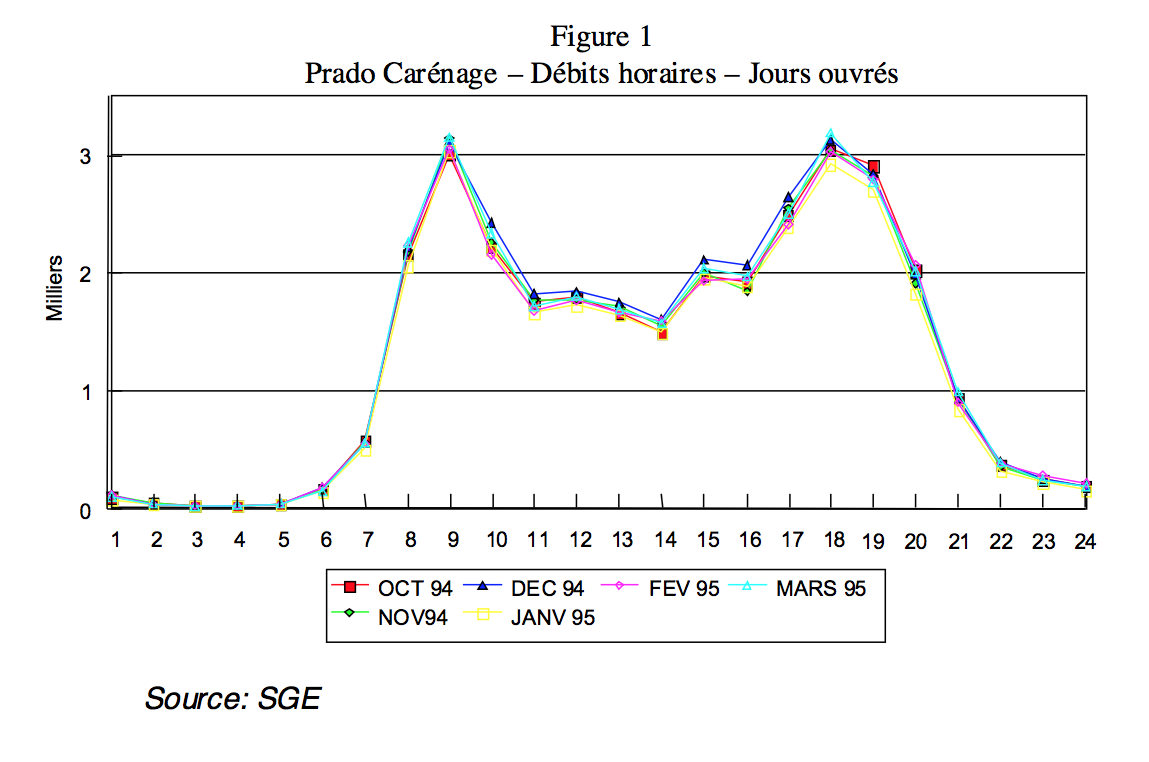
The seasonality function appears as soon as we do a statistical analysis of the measurements. We can clearly distinguish three periods:
– normal working days
–weekends, short vacation periods, long weekends and the six quietest weeks of the summer
– days of incidents (public transport strikes, accidents, first rain, snow,…)
On the RN 118, there are 43 normal weeks per year and 9 weeks with low traffic per year, which gives 215 normal working days per year. Assuming very roughly that there are two and a half hours of high demand in the morning and three hours in the evening, there would be 1,182 rush hours on a regular basis.
Then we must add incidents. Without taking strikes into account, road and weather incidents affected 2 % of the journeys. For this itinerary, we can consider that there are 1,200 rush hours per year.
By way of comparison, the Prado-Carénage tunnel has 900 per year, the “boulevard périphérique” south of Paris on the order of 1,800 hours per year, and the 28th of April Bridge in Lisbon 3,000 hours per year.
Demand at rush hours
This was naturally the focus of all of our attention. The figures given previously come from the equilibrium between the road offer and the demand for travel. Ideally, the rush hour demand should not exceed four hours per day, or 860 hours per year; this should be the normal rhythm of the life of a city. When this duration is exceeded, it is due to drivers who voluntarily shift their times of departure to avoid losing time in traffic jams. The duration of the rush hour period on a particular road is thus a good parameter for measurement of demand. We need only listen to radio stations that give SIER (Traffic management Administration) information to identify the most saturated roads.
Chronologically, after the usual Savigny basin on the A6, it is the A4, A1, A13, A15 highways that are most often cited in the morning. The Paris “boulevard périphérique” comes next, until late in the morning. In the evening, the pattern is different: Paris remains saturated for a long time (until about 20:30), as do the main exit roads over 3 to 5 km, upstream from bottlenecks such as the Saint-Cloud viaduct and the A86 crossroads (Saint-Maurice, Thiais tunnel).
The agglomeration functions dynamically like a car sponge. In the morning, the most distant suburban dwellers get up earliest and generate a wave-like traffic jam that propagates, on the A6 for example, from the Savigny basin (at about 6:45) to the A86 (at about 7:15) to the boulevard périphérique at about 7:45 and within Paris at about 8:15.
In the evening, the phenomenon is inverted: the sponge empties starting at 16:00, but less quickly that it filled up, because the demand for journeys is more varied (home – work journeys are not the majority) and the capacity of the roads is reduced (we will return to this point for the CD 2).
Consequently, the travel time shown in figure n° 2 measures the equilibrium position between:
– the total demand in number of trips
– the duration of the traffic jam at the Petit-Clamart crossroads

It is the interplay of the priorities that defines the functioning of the crossroads, and the rhythm of the life of the travelers. As the priority on highways is taken by those entering, the inner suburbs have priority over the outer suburbs and the inhabitants of Essonne and Yvelines must pass the Petit-Clamart crossroads before the inhabitants of the Hauts-de-Seine if they don’t want to spend too much time waiting in line. If we create an additional road, with a toll, we modify this equilibrium and its main customers will not be the inhabitants of the department that the road goes through, but rather those who are upstream.
That is why, in order to predict the behavior of car drivers, a good model must represent the potential clients in a very accurate manner, even far from the toll road scheme, and in particular appropriately describe the demand:
• where do the car captives live and where do they go;
• how many car captives are also time slots captives (because of children to be driven to school, for example);
• what is the time slot captives’ willingness to pay, taking into account transport comfort and tax effects;
• what is the frequency of triangular home – work – other reason – home journeys.
The value of time, or rather the willingness to pay
The value of transport time is an essential parameter for models and a concept to be broken down into several distinct notions (see preceding article in Transports n° 377, May-June 1996). Among these, it is households’ and businesses’ willingness to pay that we want to examine.
Concretely, the study of the current situation of the Prado-Carénage tunnel is today the best source of data.
The estimation of the average willingness to pay by after the fact adjustment of the traffic model did not produce a significant result because the adjustment of one single parameter to obtain the average traffic of the tunnel does not give a good reconstitution of the O/D traffic (origin – destination pairs).
Another approach was used, based on measurements of journey times and a survey of declared preferences, combined with a survey of the real choices of car drivers. The analysis of these surveys concluded with a breakdown of the time value according to a very dissymmetric curve, strongly spread toward the high values, with the appearance of a normal log curve (see figure n° 3), combined with a logit with parameter 0.25.
The distribution peak is at about 30 F, the median value is on the order of 50 F, and the average is on the order of 63 F. This wide variation confirms that traffic studies must assign an essential role to the socio-economic breakdown of the potential clientele.
Let us note that the results of the inquiry define the integral of the distribution curve and not the curve itself. The curve can also be considered as the sum of two curves, (a normal log curve for personal time and a Gaussian curve for billable time), rather than by a single curve with the appearance of a normal log curve.
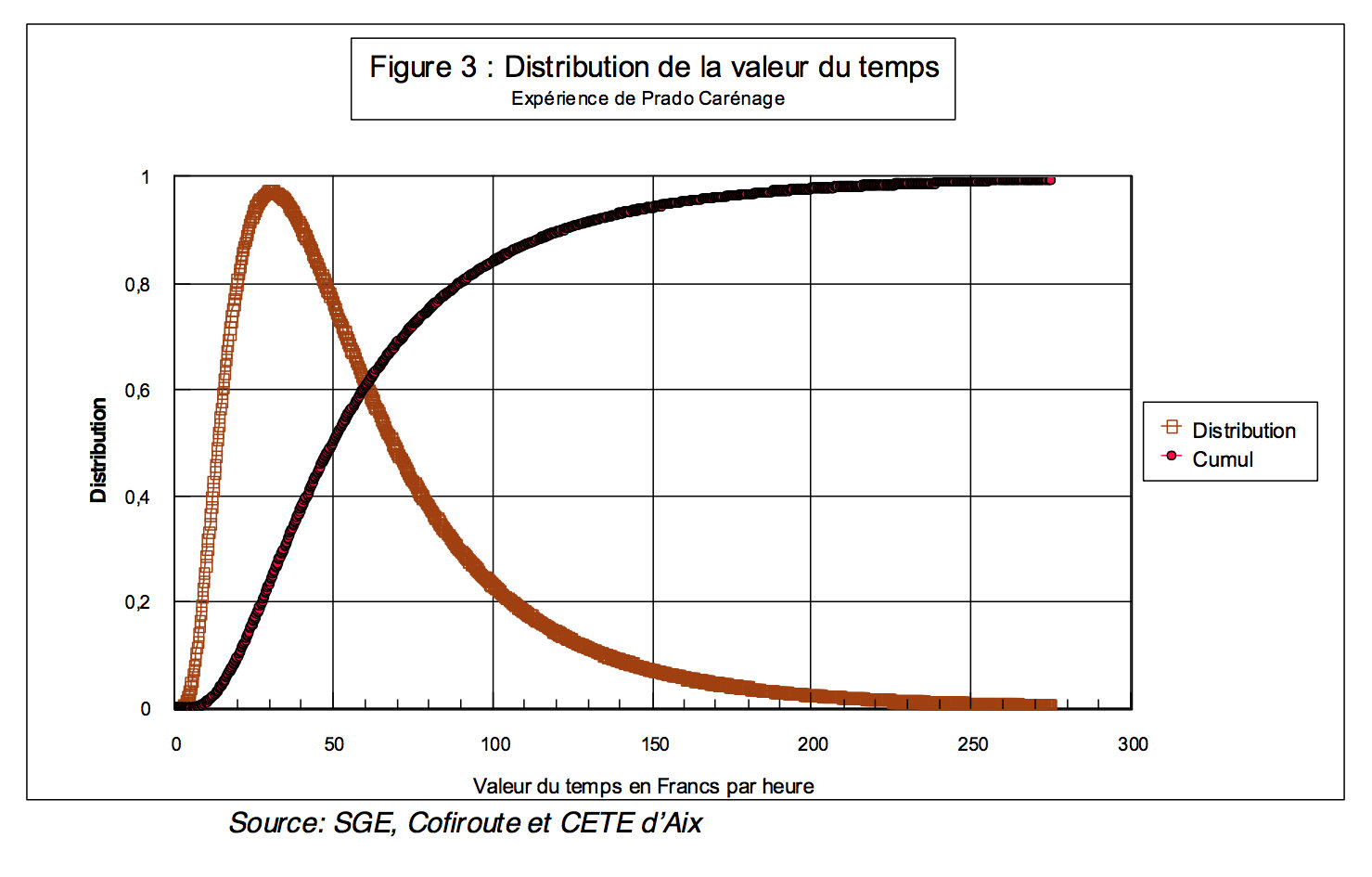
So far, traffic models have above all sought to measure the needs for journeys on the free network, and regardless of the user, because it is the role of public authorities to design an “egalitarian” network. In the case of concessions of toll roads, the problem is different: it means seeking customers who can – and agree to – pay for a specific service.
The facing map illustrates the willingness to pay of households in the Ile-de-France. The schematic calculation of the willingness must be fine tuned (“free money” divided by “free time”) by introducing a parameter reflecting comfort. This would give us a real map of the potential customers. But how do we quantify comfort? This will certainly be a key orientation in modelization research.
<img: Ile de France map>
The budget devoted to transport
Unlike journeys in open country, urban journeys are short and repetitive, morning and evening, throughout the year. If we want to check whether a proposed toll is consistent with the purchasing power of households, or the willingness to pay of companies, we must think in terms of a monthly or even annual budget.
We see that the toll that is acceptable to customers and to political decision-makers depends considerably on the following parameters:
• is the toll reimbursed by the employer?
• is the toll included in professional expenses and is it then posted as an operating expense for the company?
• can the toll be included in the real expenses declared on personal income tax returns?
• does the time savings allow the company to increase its turnover?
If the majority of potential users are reimbursed, a grantor can agpprouve a high toll level. If not, it is the willingness to pay of the households concerned by the road scheme that guides the decisions, and the toll level will be low. As in any city, we see wide discrepancies in income and areas of professional activity. There is no hope that the design of an optimal toll network will coincide with the application of tolls to road sections that public authorities have decided not to finance on their own.
The additional toll cost must, of course, be compared with the total cost of transport as seen by the potential customers. We have observed that a mandatory toll leading to an increase of 20 % in the total cost of journeys does not create political opposition movements (urban toll in Oslo for example, or the toll for the Tagus bridge). Beyond this, there is a risk of political reactions. If the toll is not mandatory, the customers have a choice and will be fewer if the toll is higher. In Marseilles, we see that the tunnel receives about 400 francs per regular customer and per month, with at least 40 % of customers being reimbursed for their journeys (regular customers represent only 4 % of the people potentially interested in the itinerary). The thinking now underway about the A14 seems to favor a monthly rate at about the level of the “carte orange” (monthly public transport travel pass), on the order of 600 francs.
This budget approach does not replace the mathematical models, but complements them and tempers their optimism, which always finds the maximum of revenues with a high toll.
While the highway toll for vacation travel or to visit family is seen as an expense that allows people to increase the time they spend at their destination, daily urban tolls are obviously seen as additional taxes, linked furthermore to the need to go to work. It is significant to see that at the Prado-Carénage tunnel in Marseilles, the evening rush hour traffic increased much more quickly that in the morning: the willingness to pay for a pleasant journey is higher than for going to work.
ROAD CAPACITY
Given constant physical conditions (width of lanes, geometric characteristics of roads and crossroads, traffic light cycles, etc.), the capacity of a road network varies as a function of the demand. The description of the network must therefore include a parameter that depends on the traffic that the network disperses, and it is within this description that the problem is expressed.
Queuing phenomena govern the capacity of roads without access to residents
All car drivers know well that when two itineraries converge, there is the risk of a traffic jam at the junction point, even if these are highway-type one-way itineraries. When the traffic is low, the capacity of the road downstream from the convergence point can accept the demand, which is the sum of the two upstream flows. This produces only a slight slowing down, which the models are capable of representing: it is the upper branch of the flow-speed curve. When the traffic is high, there is considerable slowing down, perhaps even a traffic jam. This is the lower branch of the flow-speed curve.
The Sirius system allowed for the processing of much data (3,500) on the A6a, in the direction toward Paris to represent this flow-speed curve (see figure 4). We clearly see two distinct situations:
– the first, fluid, corresponds to speeds between 90 km/h and 110 km/h.
– the other, saturated, corresponds to speeds of less than 40 km/h.

There is a rapid transition between these two situations. These measurements provide a good demonstration of the law of all or nothing for traffic on major roads without access to local residents: either you can drive quickly, or you are stuck. But current traffic models use a curve like the one shown in figure 5. These are totally unable to represent the low branch of the flow-speed curve, the branch that represents precisely the traffic conditions against which the public is protesting, and where we find the potential customers for toll roads.
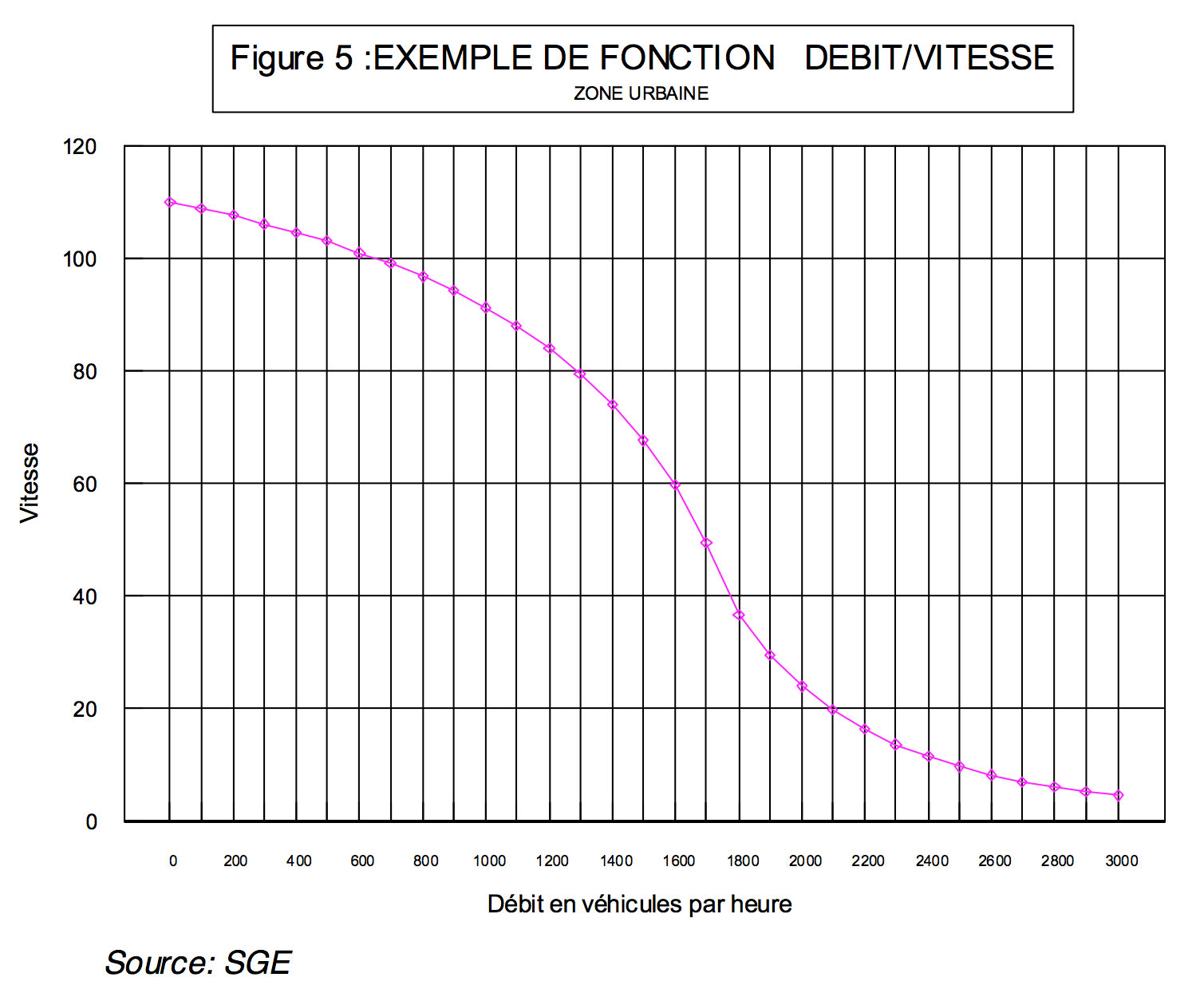
A fine analysis of the functioning of the crossroad between the RN 118 and the A86 highway at Petit Clamart, divided into half-hour sections, illustrates the phenomenon of saturation.
Schematically, the capacity of the RN 118 going towards Paris is that of the narrowest section, or two lanes towards Paris, just before the breaking into four lanes at the Sèvres Bridge. Between Petit Clamart and this narrow section there are four entrances, and only one exit, with practically no one exiting in the morning: this is then a case study analyzing the speeds and queuing phenomena caused by insertions (figure n° 6). Figure n° 7 demonstrates the fact that the speeds become higher as we approach the Sèvres Bridge, the opposite of what the models that are usually used would predict.
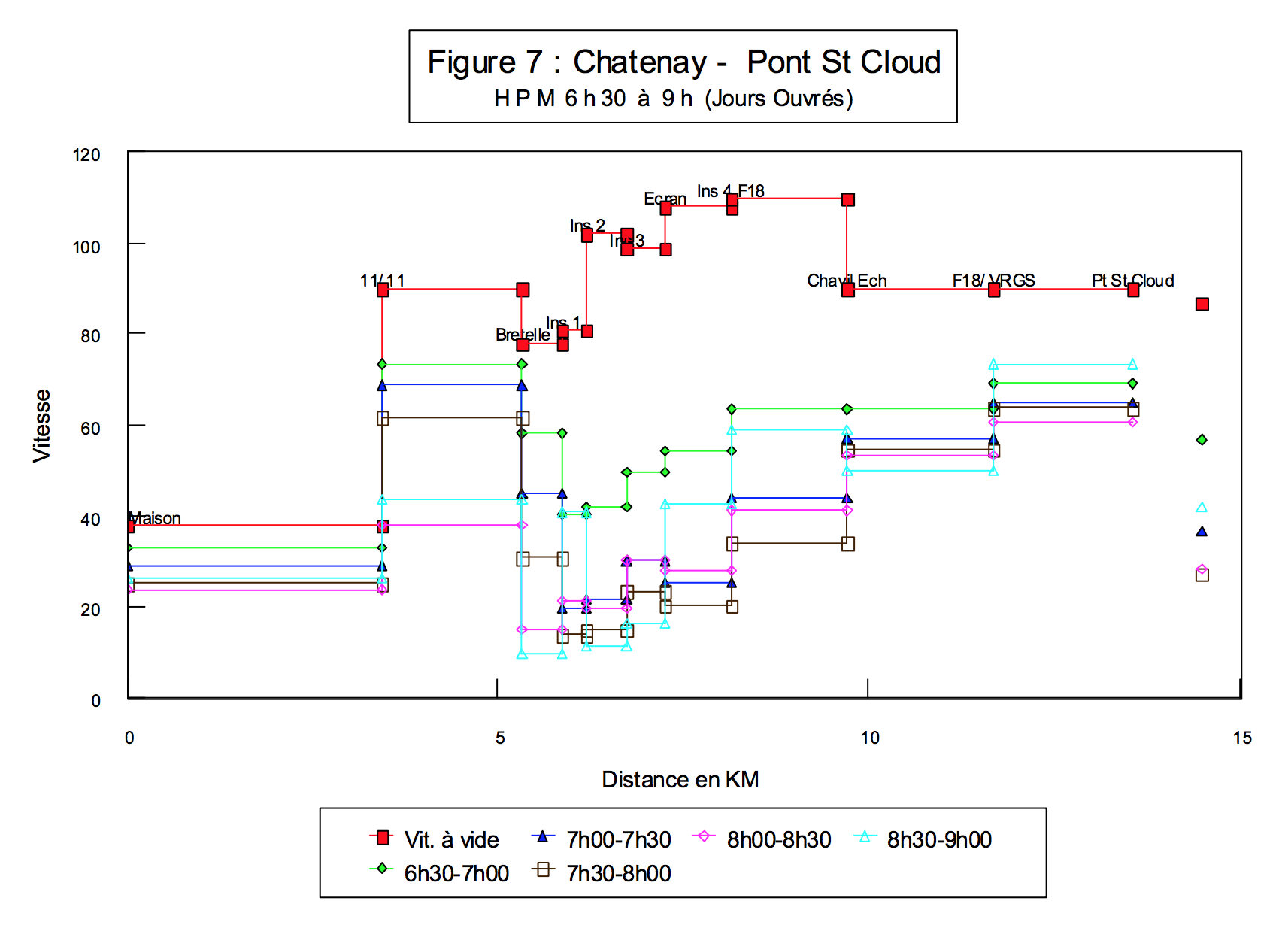
As we would expect, two situations are seen:
– fluid situation, observed early in the morning, in the middle of the day, as well as during vacations and weekends;
– saturated situation, at rush hours on working days, with increases in speed as we approach the narrowest section.
During the morning saturation period, the functioning is the result of priority laws: the right lane lets one vehicle out of two go by at each insertion. The vehicles upstream from the insertion thus have a “semi-priority” over vehicles upstream. As the vehicles upstream don’t advance quickly enough, they form a queue that goes towards Bièvres. The vehicles located the furthest downstream (coming from Chaville), benefit from the regulating effect of the upstream insertion, and enter with no problem directly into the downstream section, the most fluid, towards the Sèvres Bridge and Paris. For years now the City of Paris has known that management of fluidity on the “boulevard périphérique” depends on access control, and especially reducing insertions to a single lane.
The same phenomenon is observed in Lyons (Fourvière tunnel) where vehicles coming from Tassin have little difficulty taking the tunnel, while those from Ecully, and especially from Limonest, suffer from traffic jams of several minutes. This is also observed in Lisbon (north access to April 25 bridge), where the most fluid access is the one that is closest to the bridge, in Alcantara, while the most congested is the one in Campolide, well to the north of the access viaduct. Oslo, independently of its urban toll, shows the same characteristics on the E18 highway.
In its management of the Prado-Carénage tunnel, the operating company coordinates with the City of Marseilles so that the priority at the “Carénage” exit is given to the tunnel, with the surface lanes forming a buffer reservoir.
The flow from a highway type road in an urban area depends mainly on what happens at the downstream end of the section studied, i.e. on the fluidity of the outlet. When the end is in a zone with a high density of human activity (population + jobs per hectare), the highway is jammed during the rush hours, queues are propagated upstream, and the flow is low, despite a high theoretical capacity.
This is shown in figure n° 8, where we see that the A6a highway has, as of 7 o’clock, a low flow towards Paris than leaving Paris, although the demand is obviously higher (SIER data, analyzed by the Union Routière de France). The bottleneck is formed by the insertion of the A6a on the boulevard périphérique. The increase in highway capacity by the construction of MUSE or the A 86 West will reduce the demand on the A6a and on the RN 118. Consequently, their flows will increase, as well as their capacity for “competition” with the toll roads.
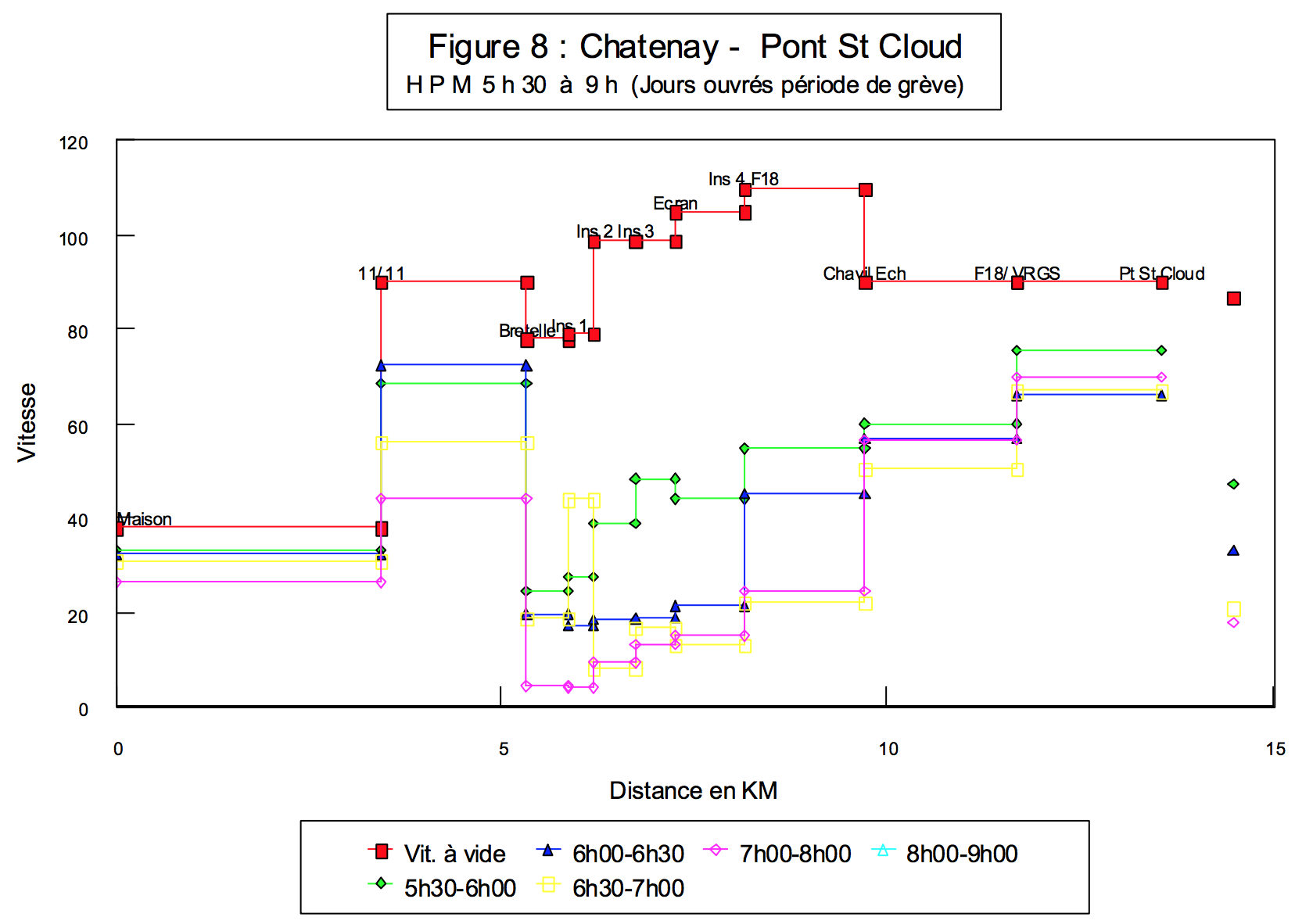
The traffic models are in principle designed to calculate the new equilibrium position, but how can they do this correctly if the flow-speed law is not properly represented?
The period of strikes of December 1995
During the strike by the public transport companies in December 1995, we continued our measurements and observed that the queuing law was indeed the predominant one in the functioning of the network. As cars entering have priority, the inner suburbs suffered less from the strikes in the morning than the other suburbs, because the traffic jams on the main roads far upstream from Paris formed a screen, preserving a relative fluidity near Paris (figure n° 9).
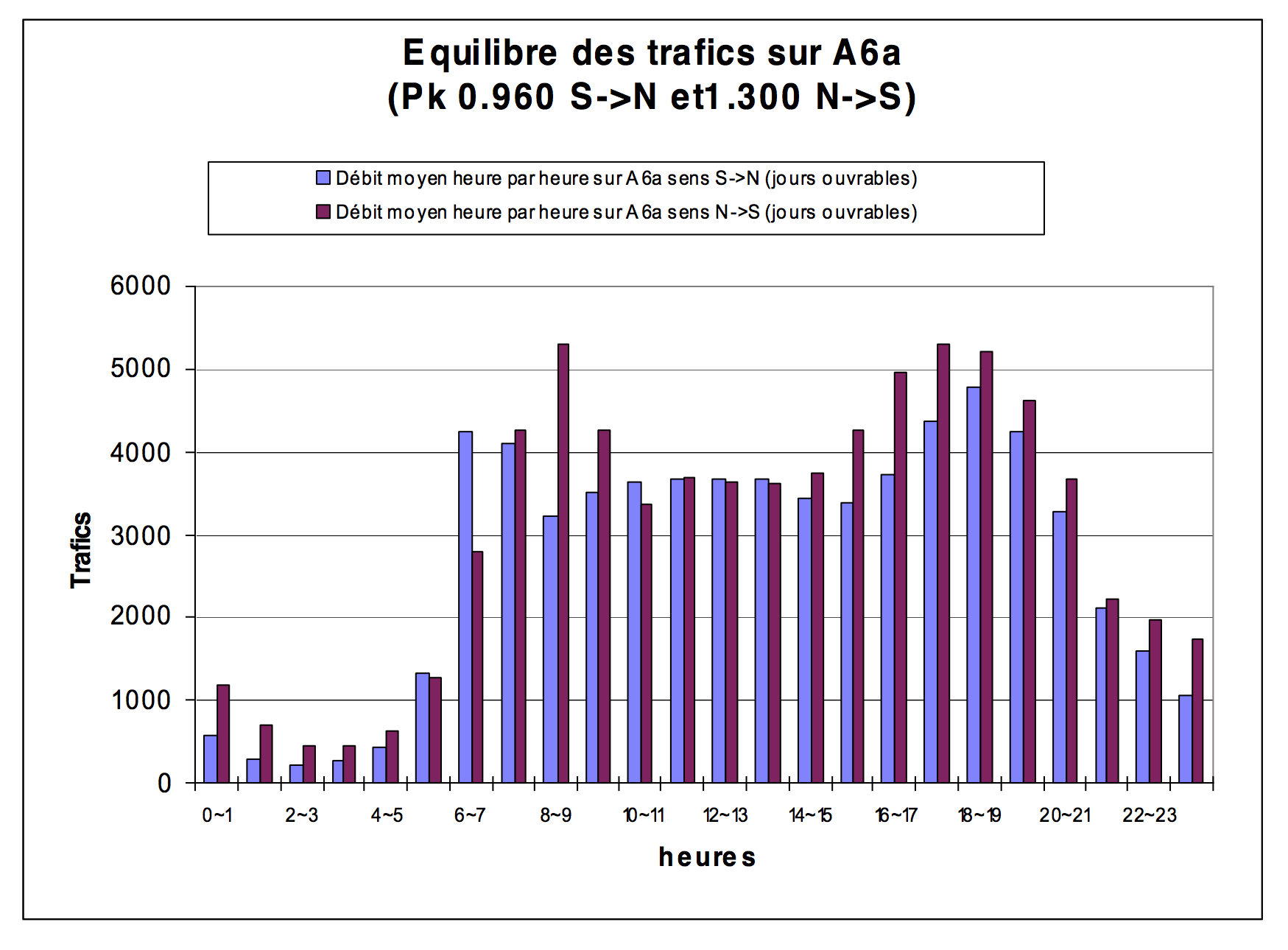
The CD 2 – roads with access to local residents
The queuing phenomenon on roads with no access to residents is easy to understand, if not to model. But on normal urban roads (streets, avenues, boulevards…), it combines with three additional phenomena:
– traffic lights;
– the use of the road by service vehicles (deliveries, buses, garbage collection, school buses, etc.), which reduce the capacity, especially if the parking is anarchic and does not leave them the necessary niches;
–vehicles that park or that leave their parking place.
– double-parked vehicles, waiting for school children…
It is naturally in city centers that the normal life activities have the greatest effect, especially in the afternoon, when there are journeys for all types of reasons. Two consequences result from this:
– the capacity of the urban road network is lower in the afternoon than in the morning, because the deliveries in the morning are over before the rush of home-work journeys;
– this lower capacity, combined with the more numerous journeys, makes the evening rush hour longer than that of the morning.
In the evening, if we add to this the additional traffic created by a dense city center (Paris) that empties out towards the suburbs that are already congested, the speeds become very low. This is the configuration described by the travel time measurements on the RD2, between Issy-les-Moulineaux and Chatenay-Malabry. The travel times are significantly longer than during the morning rush hours (figure n° 10).
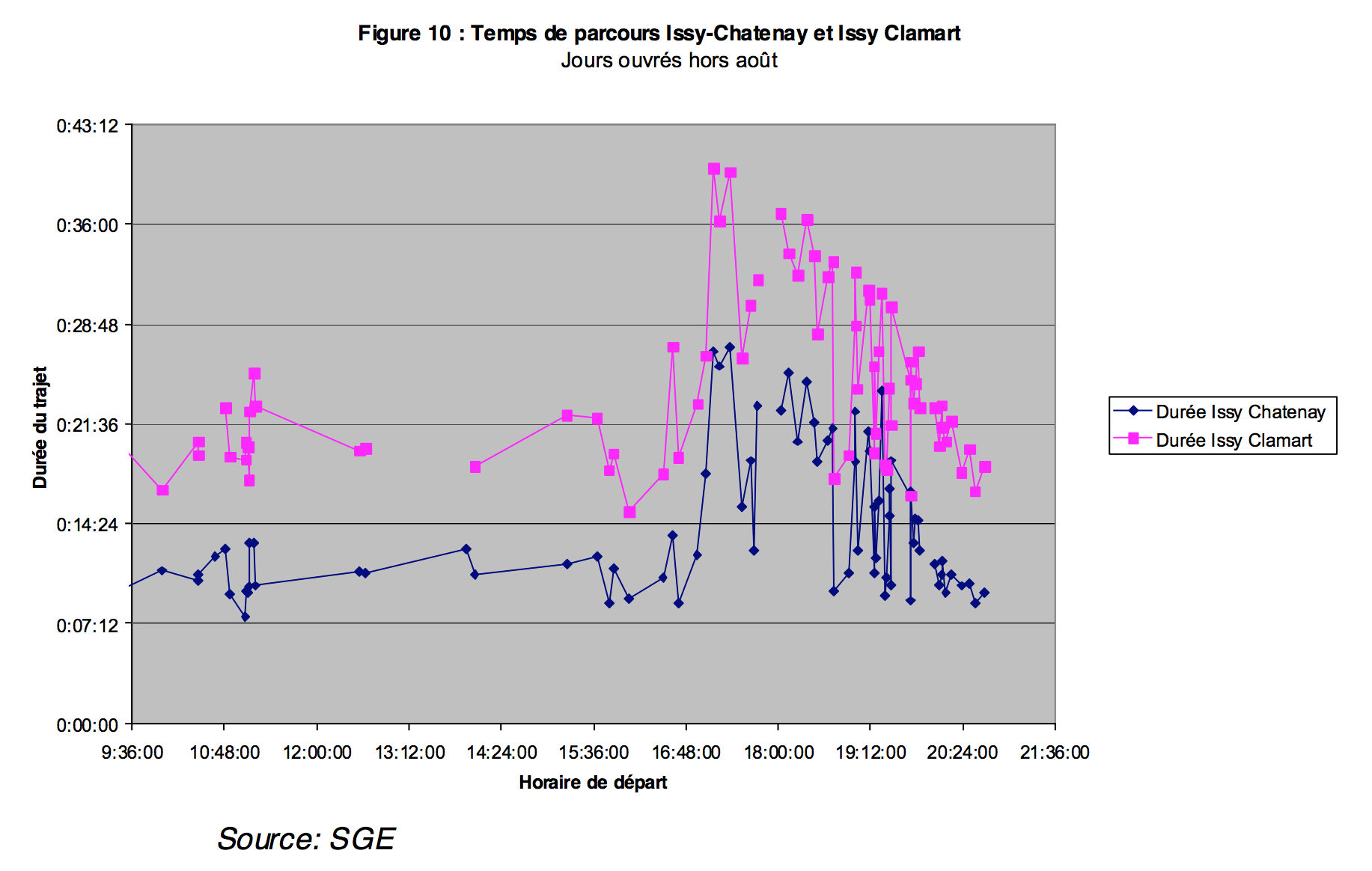
This observation does not apply to the RN 118, to which residents do not have access. On this road, the evening traffic jams leaving Paris only occur when the Vélizy shopping center adds its flow to that of the home-work journeys with, simultaneously, serious slowdowns on the A 86 which push the lines of cars up to the RN 118. Otherwise, the itinerary is always fluid. The truck traffic drops of sharply as of 17:00, before the main demand of automobile traffic, and the RN 118 offers three fluid lanes for leaving the dense area.
HIGHWAY MASTER PLAN IN ILE-DE-FRANCE
Last year, we evaluated at 5 billion francs per year the potential toll road revenues in Ile-de-France (see article in Études Foncières n° 68).
The Sirius data shed light on this estimation. Compared with a reference situation, considered to be sufficiently fluid (60 km/h on the highway, 35 km/h in Paris), it is now possible to estimate the time actually lost in traffic jams and to valuate it. The value of time in the middle of the day is greater than that of the morning or the evening, because the rate of professional travel is higher. We made a hypothesis on the variation of the value of an hour throughout the day, linked to the percentage of billable journeys.
The order of magnitude is 8 billion per year, of which only a part (perhaps one half) can be converted to tolls on well-placed roads. The result is a little more reliable than that obtained with the preceding approach (see table 11).
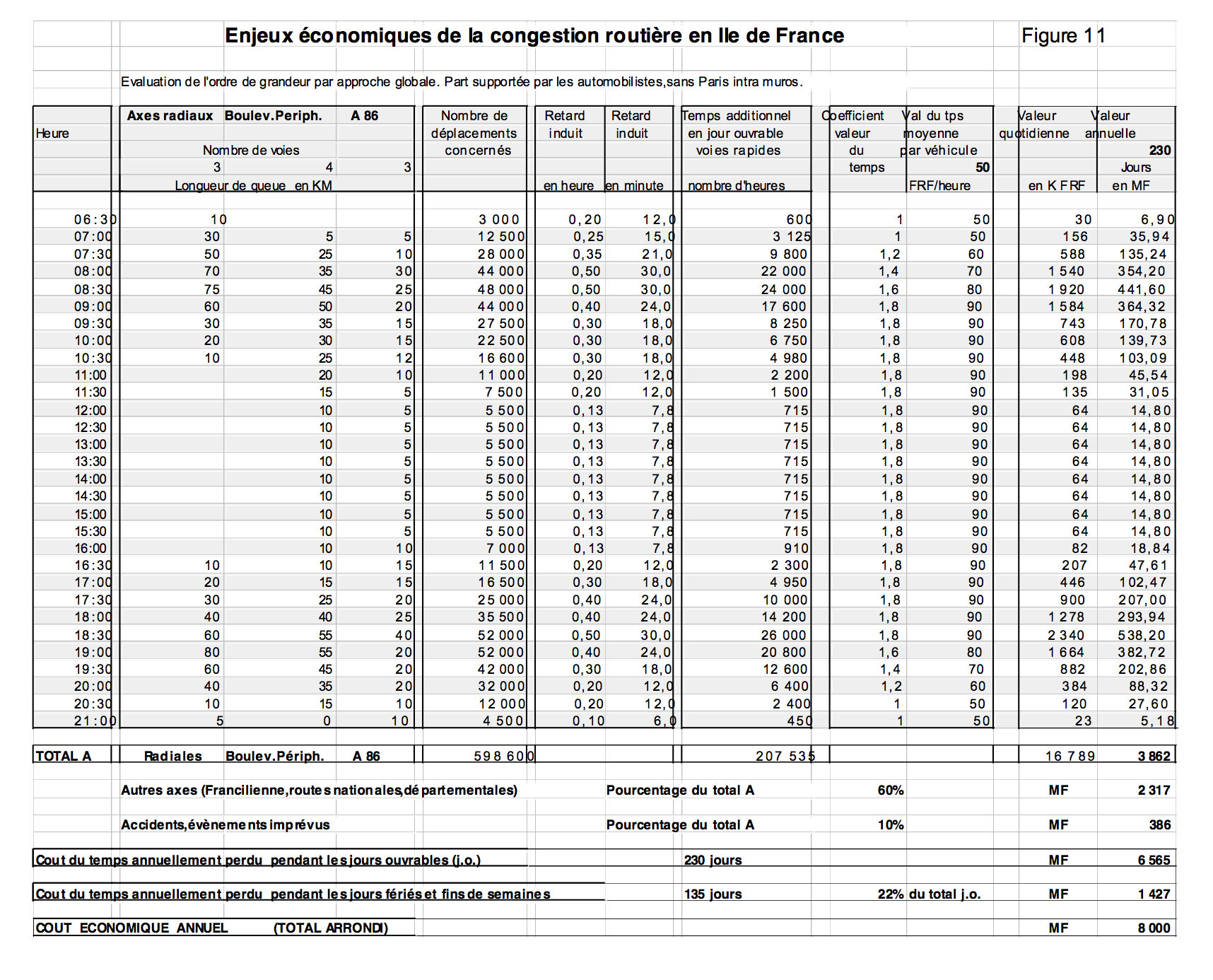
The number of journeys hindered by traffic jams on workdays is on the order of one million, corresponding to 500,000 vehicles (300,000 on major roads, plus about 60 % on secondary roads), or 10 % of the total number of cars in the Ile-de-France.
Let us remember that automobile expenditures represent annually 135 billion francs, including 105 paid by households and 30 by companies. The 4 billion for tolls would represent only 3 % of the total expenditures, which is low. But only a fraction of the population is involved.
The real issues then appear to be:
– what are the new itineraries that will be the most desired, and the most capable of mobilizing these 4 billion?
– are these itineraries desired by a solvent clientele?
– how much will their construction cost?
While awaiting the hypothetical development of a traffic model that is representative of urban traffic, the pressure of the demand for travel will be measured by the length of traffic jams at critical crossroads, and especially the daily duration of these traffic jams. This is where the use of the Sirius data will be particularly useful.
By enriching the road network with roads that relieve those for which the duration of the traffic jams is longest, the number of hours of use of the additional infrastructure will be maximized, as will the return (socio-economic or financial). The voluntary reduction of the capacity of the existing free roads would only be justified as a complementary measure, or as a prior condition for a broad urbanization operation.
The methodological uncertainties for forecasting of receipts in urban areas are such that it seems reasonable to limit the amount to be invested per project. Perhaps we should develop the idea of a “test section” while awaiting the first years of operation of the A14 (Orgeval – la Défense) and the “Boulevard Périphérique Nord” in Lyon?
It is certain in any case that the logic of maximum use of infrastructure would lead us to offer toll roads with alternating directions. The USA and Brazil have used this system for some years now. The toll road, complementary to the free network, is used in one direction in the morning and in the other in the evening, in order to maximize the number of hours of use.
We could also use toll modulation.
If alternation of directions poses complicated problems, and we want to minimize the investment, it is obviously in the direction leaving areas of high human activity dense that we would orient one-way toll roads. Whether from a financial (longer rush hour) or urbanism standpoint (limitation of automobile traffic for personal reasons in areas of highest densities), an exit road would be a better solution that an entrance road, and would hardly increase the total traffic.
CONCLUSION
The construction of a road in a dense urban area is a social and urban matter, not just a matter of transport. The current weaknesses of traffic models are of three types:
– from a strictly technical standpoint, they do not adequately represent queuing phenomena, which are the most important in the choice of itineraries;
– from a behavior standpoint, the poor quality of the available data prevents us from defining an appropriate segmentation of users of roads or public transport.
– from an urban standpoint, the esthetic, social and architectural value of developed areas cut by a road is not represented by any parameter of the model.
A toll road offers a particular service, to a precise clientele, with a high temporal added value. Regulation with a toll poses a political problem that must be carefully analyzed, especially if there is a share of public funding for the structures to be built. The economic models remain to be determined, to evaluate both the redistributing aspect of such solutions and the structural economic impact that they generate, well beyond the mere valuation of the time saved.
Also, from a strictly budgetary standpoint, the Ile-de-France development plan is absolutely unfinanceable with the current budgetary possibilities. That this doesn’t bother decision-makers is yet another paradox that puts the validity of our modes of understanding reality into doubt.
